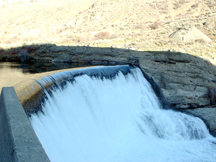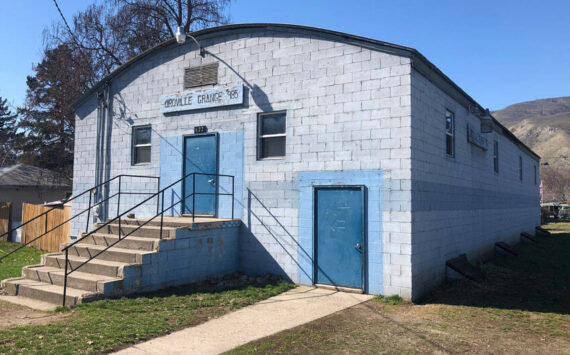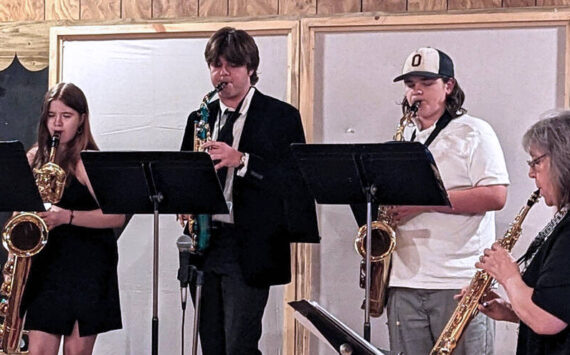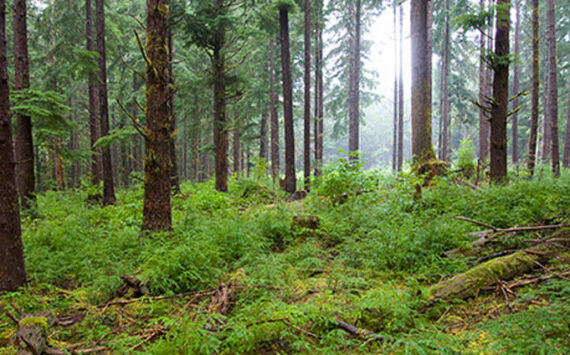

The spillway at Enloe Dam as viewed from the west side of the river. The dam, originally built in the 1920s, has not produced electric power since the late 1950’s. The Dam was constructed on top of a natural 18-foot falls. Photo by Gary DeVon
OROVILLE – Several conservation groups are calling Okanogan County PUD’s attempts at re-starting hydroelectric power generation at Enloe Dam a money losing proposition – now and in the future.
However, Okanogan County PUD Commissioner Ernie Bolz said it was too soon to know what the actual costs of power generation will be as the final permit has not been issued.
On Tuesday, Jan. 24, 2012, the Columbia Bioregional Education Project (CBEP), joined by several conservation groups, issued a new economic analysis of Okanogan Public Utility District’s (PUD) proposal to re-start hydropower generation at Enloe Dam on the Similkameen River. The analysis, prepared by Rocky Mountain Econometrics (RME) of Boise, Idaho, concludes that it is not possible for the PUD to sell power from Enloe Dam at or above the cost of producing it, and that the PUD will lose $26 for every megawatt hour produced at the dam.
“Okanogan PUD ratepayers are going to take a big hit for this expensive and unprofitable project,” said Jere Gillespie of CBEP. “We are calling on the Okanogan PUD to replace its out-of-date 2008 analysis and provide ratepayers with a realistic evaluation of Enloe Dam economics. We think such an update will show that the dam project is not a wise investment for ratepayers and should be dropped.”
Commissioner Bolz agrees that the costs need to be based on current information.
“We don’t have the license yet so we don’t know what the actual mitigation requirements will be. We need that before we can compute the cost of construction on the realities of today, rather than the application we made in 2008,” said Commissioner Bolz. “The made their analisis on an application we have made, not on the final permit. Until we have that they’re just blowing in the wind.”
Okanogan County PUD has asked the Federal Energy Regulatory Commission (FERC) to issue a license to install turbines at the existing Enloe Dam, which blocks the Similkameen River about four miles west of Oroville. Originally built in the early 1900’s, Enloe Dam has not generated hydropower since 1958. The current license application, pending with FERC since 2008, is the PUD’s fourth attempt since the mid-1980’s to add power generation to the dam. Previous licensing efforts failed due to poor economics and fish passage issues.
The Rocky Mountain Econometrics report reviewed the economic data provided by the power utilitiy as part of its August 2008 FERC license application. The RME economic analysis concludes that:
Market conditions for power have changed dramatically since 2008.
Construction costs for projects similar to Enloe have increased by 30% since 2008
Open market prices for electricity, which will dictate what the PUD can sell Enloe power for, have decreased by 50%
According to the analysis, the long-term price for Enloe power is more likely to be $43/megawatt hour (MWh) than the $66/MWh predicted by Okanogan PUD in 2008. Okanogan County PUD’s 2008 analysis did not consider lost revenues due to tourism generated by Similkameen Falls. This report shows that, over the life of the license term, tourism losses for the Okanogan region could approach $20 million, two-thirds of the original 2008 estimate to build this uneconomic dam, say the conservation groups.
“The negative economics and significant impacts to local tourism make Enloe a poor plan for the utility and for Okanogan ratepayers,” said Rich Bowers, regional coordinator for the Hydropower Reform
Coalition. “While forecasts continually change, there is a great difference between today’s economic forecast than in 2008 when the original economic analysis was prepared.”
The groups goes on to say PUD expenditures have been a continuing drain for its ratepayers. On Dec. 2, 2011 the PUD raised retail power rates in order to meet increasing operational expenses. In addition, on Dec.20, the PUD adopted a budget for 2012 that reveals a five-fold increase in capital expenditures since 2007 (from $5.7 million to $24.5 million), and more than two-fold increase in debt principal and interest for the same period (from $1.6 million to $3.5 million).
“Enloe Dam has not operated for 50 years,” said Rachael Paschal Osborn, with the Center for Environmental Law & Policy. “In the context of its current budget, Okanogan PUD simply cannot afford to sink additional money into a project which will greatly increase rates for Okanogan ratepayers.”
The Enloe Dam project has been controversial for both environmental and economic reasons. Of particular concern is the current proposal to bypass virtually all of the river flow into the new turbines, de-watering Similkameen Falls for most of the year. The Falls represent an important cultural/historical resource for Native American Tribes and First Nations in the area. The Falls also represent a viewpoint/terminus for the newly developed Similkameen River Trail, which occupies the abandoned Great Northern Railway rail bed and is to be designated as a segment of the 1,200-mile Pacific Northwest National Scenic Trail, which runs from the continental divide in Montana to Olympic National Park. The tourist draw of the Similkameen River Trail is expected to bring significant revenue to the Oroville area.
“The Similkameen River and its waterfalls have recreational values that will enhance the tourism economy of the Okanogan-Similkameen Valleys. This report shows that de-watering the falls by the dam could cost $516,000 per year in lost tourism value,” said Thomas O’Keefe, Pacific Northwest Stewardship Director for American Whitewater.
Bolz reminds people that when power was generated at the dam before little water dropped over the spillway and instead most was diverted through penstocks to the old powerhouse. He also questioned the comparisons of the Similkameen Falls with other waterfalls cited in the report as tourist actractions.
Rocky Mountain Econometrics produced the Enloe report on behalf of Hydropower Reform Coalition members Columbia Bioregional Education Project, American Rivers, American Whitewater, Center for Environmental Law & Policy, North Cascades Conservation Council, and the Washington State Chapter of Sierra Club.
The RME Report may be downloaded at the following sites:
American Whitewater Similkameen River website: http://www.americanwhitewater.org/content/Project/view/id/similkameen/
American Rivers website:
http://amrivers.org
Center for Environmental Law & Policy Enloe Dam website: http://www.columbia-institute.org/enloe/dam.html
Columbia River Bioregional Education Project website: http://www.columbiana.org/pages/enloe_dam.html
Hydropower Reform Coalition website:
http://www.hydroreform.org/







